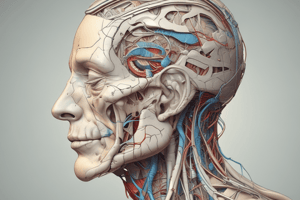Podcast
Questions and Answers
The facial skin receives its nerve supply from branches of the facial nerve in three distinct zones.
The facial skin receives its nerve supply from branches of the facial nerve in three distinct zones.
False (B)
The zones supplied by the three divisions of the trigeminal nerve meet at the margins of the eyelids and the angles of the mouth, with junction lines curving downwards.
The zones supplied by the three divisions of the trigeminal nerve meet at the margins of the eyelids and the angles of the mouth, with junction lines curving downwards.
False (B)
The area of skin originally supplied by the mandibular nerve was directly over the zygomatic arch.
The area of skin originally supplied by the mandibular nerve was directly over the zygomatic arch.
False (B)
The expansion of the cranial cavity results in the drawing of beard skin over the temple, and neck skin replaces the beard skin.
The expansion of the cranial cavity results in the drawing of beard skin over the temple, and neck skin replaces the beard skin.
The term 'temple' is derived from the observation that this area is often the last part to show signs of aging.
The term 'temple' is derived from the observation that this area is often the last part to show signs of aging.
The skin over the angle of the mandible is innervated by a branch of the mandibular division of the trigeminal nerve (V3).
The skin over the angle of the mandible is innervated by a branch of the mandibular division of the trigeminal nerve (V3).
The area around the mouth and lower part of the nose is innervated by the C2 dermatome.
The area around the mouth and lower part of the nose is innervated by the C2 dermatome.
The lacrimal nerve, a branch of the ophthalmic nerve, supplies a small area of skin over the medial part of the upper lid.
The lacrimal nerve, a branch of the ophthalmic nerve, supplies a small area of skin over the medial part of the upper lid.
The muscles of facial expression receive proprioceptive fibers exclusively from the facial nerve.
The muscles of facial expression receive proprioceptive fibers exclusively from the facial nerve.
The ophthalmic division of the trigeminal nerve gives rise to three cutaneous branches.
The ophthalmic division of the trigeminal nerve gives rise to three cutaneous branches.
The supraorbital nerve emerges through the frontal notch or foramen and supplies the forehead and scalp up to the vertex, after breaking into approximately two to three branches.
The supraorbital nerve emerges through the frontal notch or foramen and supplies the forehead and scalp up to the vertex, after breaking into approximately two to three branches.
The infratrochlear nerve, a branch of the ophthalmic nerve, exclusively supplies skin of the lower lid.
The infratrochlear nerve, a branch of the ophthalmic nerve, exclusively supplies skin of the lower lid.
During a herpes zoster infection affecting the trigeminal ganglion, the ophthalmic and maxillary nerves are less frequently affected than the mandibular nerve.
During a herpes zoster infection affecting the trigeminal ganglion, the ophthalmic and maxillary nerves are less frequently affected than the mandibular nerve.
Pain fibers in the trigeminal nerve are arranged in a somatotopic 'onion-skin' pattern relative to the cochlear nucleus of the trigeminal nerve.
Pain fibers in the trigeminal nerve are arranged in a somatotopic 'onion-skin' pattern relative to the cochlear nucleus of the trigeminal nerve.
In herpes zoster, involvement of the external nasal nerve suggests the potential for corneal involvement because the cornea is supplied by branches of the facial nerve.
In herpes zoster, involvement of the external nasal nerve suggests the potential for corneal involvement because the cornea is supplied by branches of the facial nerve.
The infraorbital nerve supplies palpebral branches to the upper eyelid, nasal branches to the side and ala of the nose, and labial branches to the lower lip.
The infraorbital nerve supplies palpebral branches to the upper eyelid, nasal branches to the side and ala of the nose, and labial branches to the lower lip.
The zygomaticotemporal nerve emerges in the temporal fossa and supplies a small area of skin over the front of the temple on a level with the lower eyelid.
The zygomaticotemporal nerve emerges in the temporal fossa and supplies a small area of skin over the front of the temple on a level with the lower eyelid.
The auriculotemporal nerve supplies the skin of the auricle above the level of the external acoustic meatus. It also supplies the surface of the tympanic membrane.
The auriculotemporal nerve supplies the skin of the auricle above the level of the external acoustic meatus. It also supplies the surface of the tympanic membrane.
The buccal nerve provides cutaneous innervation to a 'thumb print' area over the cheek just below the zygomatic bone, between the areas of the infraorbital nerve and the lesser occipital nerve.
The buccal nerve provides cutaneous innervation to a 'thumb print' area over the cheek just below the zygomatic bone, between the areas of the infraorbital nerve and the lesser occipital nerve.
The mental nerve supplies the skin and mucous membrane of the lower lip and labial gum from the midline to about the first premolar tooth.
The mental nerve supplies the skin and mucous membrane of the lower lip and labial gum from the midline to about the first premolar tooth.
Flashcards
Lacrimal Nerve
Lacrimal Nerve
Supplies skin over the lateral part of the upper eyelid.
Supraorbital Nerve
Supraorbital Nerve
Supplies the forehead and scalp up to the vertex.
Supratrochlear Nerve
Supratrochlear Nerve
Supplies the middle of the forehead up to the hairline.
Infratrochlear Nerve
Infratrochlear Nerve
Signup and view all the flashcards
External Nasal Nerve
External Nasal Nerve
Signup and view all the flashcards
Infraorbital Nerve
Infraorbital Nerve
Signup and view all the flashcards
Zygomaticofacial Nerve
Zygomaticofacial Nerve
Signup and view all the flashcards
Zygomaticotemporal Nerve
Zygomaticotemporal Nerve
Signup and view all the flashcards
Auriculotemporal Nerve
Auriculotemporal Nerve
Signup and view all the flashcards
Buccal Nerve
Buccal Nerve
Signup and view all the flashcards
Facial Skin Nerve Supply
Facial Skin Nerve Supply
Signup and view all the flashcards
Trigeminal Cutaneous Branches
Trigeminal Cutaneous Branches
Signup and view all the flashcards
Angle of Mandible Nerve Supply
Angle of Mandible Nerve Supply
Signup and view all the flashcards
Facial Muscle Proprioception
Facial Muscle Proprioception
Signup and view all the flashcards
Trigeminal Nerve Mapping
Trigeminal Nerve Mapping
Signup and view all the flashcards
'Onion-Skin' Pain Pattern
'Onion-Skin' Pain Pattern
Signup and view all the flashcards
Original Trigeminal Zones
Original Trigeminal Zones
Signup and view all the flashcards
Cranial Cavity Expansion
Cranial Cavity Expansion
Signup and view all the flashcards
Location of Greying Hairs
Location of Greying Hairs
Signup and view all the flashcards
Trigeminal Nerve Divisions
Trigeminal Nerve Divisions
Signup and view all the flashcards
Study Notes
- The facial skin is supplied by branches of the trigeminal nerve’s three divisions, meeting at the eyelids' margins and mouth angles.
- The junction lines of these zones curve upwards due to developmental changes.
- Initially, the trigeminal nerve branches met along horizontal lines from the eye and mouth angles.
- The skin innervated by the mandibular nerve (lowest trigeminal branch) was originally over the mandible.
- The auriculotemporal branch's area was first over the mandible's angle.
- As the cranial cavity expands, facial skin is drawn over it, moving beard skin over the temple and neck skin upwards.
- The temple is named for being the first area to show aging via graying hairs.
- The great auricular nerve supplies the skin over the mandibular angle and above.
- Facial muscles receive proprioceptive fibers from the cutaneous nerves, which connect with the facial nerve branches.
- The trigeminal nerve's divisions (ophthalmic, maxillary, and mandibular) give off cutaneous branches.
- Ophthalmic nerve gives off five cutaneous branches.
- Maxillary nerve gives off three cutaneous branches.
- Mandibular nerve gives off three cutaneous branches.
- Facial haemangiomas or herpes zoster rashes often demonstrate the skin area supplied by the trigeminal nerve's main branches.
- Herpes zoster less commonly affects the mandibular nerve, unlike the ophthalmic and maxillary nerves.
- Pain fibers in the trigeminal nerve are arranged in an 'onion-skin' pattern as they synapse with the spinal nucleus of the trigeminal nerve.
- The mouth area and lower nose are supplied by fibers connecting to the spinal nucleus' highest (pontine) part, followed by concentric areas connecting to progressively lower levels.
- The onion-skin arrangement for pain does not precisely match the sensory distribution of the main nerves.
Ophthalmic Nerve
- Five cutaneous branches exist.
- The lacrimal nerve supplies skin over the upper lid's lateral part.
- The supraorbital nerve passes up through a notch or foramen, branching to supply the forehead and scalp up to the vertex.
- The supratrochlear nerve ascends medially to the supraorbital nerve, supplying the mid-forehead up to the hairline.
- Above the hairline, the supraorbital nerves meet in the midline up to the vertex.
- The infratrochlear nerve supplies skin on the upper lid's medial part, descending along the external nose.
- It supplies skin over the nose's "bridge" but not the lower lid.
- The external nasal nerve supplies the middle of the external nose down to the tip.
- Involvement of this nerve in herpes zoster suggests potential corneal involvement.
- The cornea is supplied by ciliary branches of the same nerve which may lead to ulceration.
- The four branches also supply the upper lid conjunctiva.
Maxillary Nerve
- Composed of three cutaneous branches.
- The infraorbital nerve emerges through its foramen, branching to supply the lower eyelid, cheek, nose side and ala, upper lip, and labial gum up to the second premolar.
- It is located between the levator labii superioris and levator anguli oris.
- Many twigs connect to facial nerve branches for proprioceptive supply of face muscles.
- The zygomaticofacial nerve emerges from a foramen on the zygomatic bone's outer surface, supplying the overlying skin.
- The zygomaticotemporal nerve emerges in the temporal fossa through a foramen in the zygomatic bone's posterior surface.
- It supplies skin over the front of the temple level with the upper eyelid.
Mandibular Nerve
- Composed of three cutaneous branches.
- The auriculotemporal nerve passes around the mandible's neck, ascending behind the superficial temporal vessels.
- Its auricular part supplies the external acoustic meatus, tympanic membrane surface, and auricle skin above this level.
- Its temporal part supplies the hairy skin over the temple, where grey hairs commonly appear first.
- The buccal nerve gives off cutaneous twigs that supply a "thumb print" area over the cheek below the zygomatic bone.
- This is between the areas of the infraorbital nerve and the great auricular nerve.
- The mental nerve is a cutaneous branch of the inferior alveolar nerve, supplying the skin and mucous membrane of the lower lip and labial gum up to the second premolar tooth.
Studying That Suits You
Use AI to generate personalized quizzes and flashcards to suit your learning preferences.




